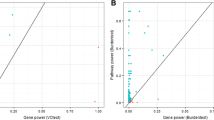Abstract
Purely epistatic multi-locus interactions cannot generally be detected via single-locus analysis in case-control studies of complex diseases. Recently, many two-locus and multi-locus analysis techniques have been shown to be promising for the epistasis detection. However, exhaustive multi-locus analysis requires prohibitively large computational efforts when problems involve large-scale or genome-wide data. Furthermore, there is no explicit proof that a combination of multiple two-locus analyses can lead to the correct identification of multi-locus interactions. 2LOmb which performs an omnibus permutation test on ensembles of two-locus analyses is proposed. The algorithm consists of four main steps: two-locus analysis, a permutation test, global p-value determination and a progressive search for the best ensemble. 2LOmb is benchmarked against a set association approach, a correlation-based feature selection technique and a tuned ReliefF technique. The simulation results from multi-locus interaction problems indicate that 2LOmb has a low false-positive error. Moreover, 2LOmb has the best performance in terms of an ability to identify all causative single nucleotide polymorphisms (SNPs), which signifies a high detection power. 2LOmb is subsequently applied to type 1 and type 2 diabetes mellitus (T1D and T2D) data sets, which are obtained as a part of the UK genome-wide genetic epidemiology study by the Wellcome Trust Case Control Consortium. After primarily screening for SNPs that locate within or near candidate genes and exhibit no marginal single-locus effects, the T1D and T2D data sets are reduced to 2,359 SNPs from 350 genes and 7,065 SNPs from 370 genes, respectively. The 2LOmb search reveals that 28 SNPs in 21 genes are associated with T1D while 11 SNPs in four genes are associated with T2D. The findings provide an alternative explanation for the aetiology of T1D and T2D in a UK population.
Preview
Unable to display preview. Download preview PDF.
Similar content being viewed by others
References
Risch, N., Merikangas, K.: The Future of Genetic Studies of Complex Human Diseases. Science 273, 1516–1517 (1996)
Musani, S.K., Shriner, D., Liu, N., Feng, R., Coffey, C.S., Yi, N., Tiwari, H.K., Allison, D.B.: Detection of Gene × Gene Interactions in Genome-Wide Association Studies of Human Population Data. Hum. Hered. 63, 67–84 (2007)
The Wellcome Trust Case Control Consortium: Genome-Wide Association Study of 14,000 Cases of Seven Common Diseases and 3,000 Shared Controls. Nature 447, 661–678 (2007)
The GAIN Collaborative Research Group: New Models of Collaboration in Genome-Wide Association Studies: the Genetic Association Information Network. Nat. Genet. 39, 1045–1051 (2007)
Heidema, A.G., Boer, J.M.A., Nagelkerke, N., Mariman, E.C.M., van der A, D.L., Feskens, E.J.M.: The Challenge for Genetic Epidemiologists: How to Analyze Large Numbers of SNPs in Relation to Complex Diseases. BMC Genet. 7, 23 (2006)
Motsinger, A.A., Ritchie, M.D., Reif, D.M.: Novel Methods for Detecting Epistasis in Pharmacogenomics Studies. Pharmacogenomics 8, 1229–1241 (2007)
Moore, J.H., Gilbert, J.C., Tsai, C.T., Chiang, F.T., Holden, T., Barney, N., White, B.C.: A Flexible Computational Framework for Detecting, Characterizing, and Interpreting Statistical Patterns of Epistasis in Genetic Studies of Human Disease Susceptibility. J. Theor. Biol. 241, 252–261 (2006)
Hall, M.A., Holmes, G.: Benchmarking Attribute Selection Techniques for Discrete Class Data Mining. IEEE Trans. Knowl. Data Eng. 15, 1437–1447 (2003)
Cordell, H.J.: Epistasis: What It Means, What It Doesn’t Mean, and Statistical Methods to Detect It in Humans. Hum. Mol. Genet. 11, 2463–2468 (2002)
Neuman, R.J., Rice, J.P.: Two-Locus Models of Disease. Genet. Epidemiol. 9, 347–365 (1992)
Schork, N.J., Boehnke, M., Terwilliger, J.D., Ott, J.: Two-Trait-Locus Linkage Analysis: a Powerful Strategy for Mapping Complex Genetic Traits. Am. J. Hum. Genet. 53, 1127–1136 (1993)
Li, W., Reich, J.: A Complete Enumeration and Classification of Two-Locus Disease Models. Hum. Hered. 50, 334–349 (2000)
Marchini, J., Donnelly, P., Cardon, L.R.: Genome-Wide Strategies for Detecting Multiple Loci That Influence Complex Diseases. Nat. Genet. 37, 413–417 (2005)
Hallgrímsdóttir, I.B., Yuster, D.S.: A Complete Classification of Epistatic Two-Locus Models. BMC Genet. 9, 17 (2008)
Culverhouse, R., Suarez, B.K., Lin, J., Reich, T.: A Perspective on Epistasis: Limits of Models Displaying No Main Effect. Am. J. Hum. Genet. 70, 461–471 (2002)
Hoh, J., Wille, A., Ott, J.: Trimming, Weighting, and Grouping SNPs in Human Case-Control Association Studies. Genome Res. 11, 2115–2119 (2001)
Heidema, A.G., Feskens, E.J.M., Doevendans, P.A.F.M., Ruven, H.J.T., van Houwelingen, H.C., Mariman, E.C.M., Boer, J.M.A.: Analysis of Multiple SNPs in Genetic Association Studies: Comparison of Three Multi-locus Methods to Prioritize and Select SNPs. Genet. Epidemiol. 31, 910–921 (2007)
Gayán, J., González-Pérez, A., Bermudo, F., Sáez, M.E., Royo, J.L., Quintas, A., Galan, J.J., Morón, F.J., Ramirez-Lorca, R., Real, L.M., Ruiz, A.: A Method for Detecting Epistasis in Genome-Wide Studies Using Case-Control Multi-locus Association Analysis. BMC Genomics 9, 360 (2008)
Moore, J.H., White, B.C.: Tuning ReliefF for Genome-Wide Genetic Analysis. In: Marchiori, E., Moore, J.H., Rajapakse, J.C. (eds.) EvoBIO 2007. LNCS, vol. 4447, pp. 166–175. Springer, Heidelberg (2007)
Hardy, G.H.: Mendelian Proportions in a Mixed Population. Science 28, 49–50 (1908)
Dudek, S.M., Motsinger, A.A., Velez, D.R., Williams, S.M., Ritchie, M.D.: Data Simulation Software for Whole-Genome Association and Other Studies in Human Genetics. In: Altman, R.B., Dunker, A.K., Hunter, L., Murray, T., Klein, T.E. (eds.) Proceedings of the Pacific Symposium on Biocomputing 2006, pp. 499–510. World Scientific, Singapore (2006)
Yu, W., Gwinn, M., Clyne, M., Yesupriya, A., Khoury, M.J.: A Navigator for Human Genome Epidemiology. Nat. Genet. 40, 124–125 (2008)
Press, W.H., Teukolsky, S.A., Vetterling, W.T., Flannery, B.P.: Numerical Recipes in C: The Art of Scientific Computing, 2nd edn. Cambridge University Press, Cambridge (1992)
Author information
Authors and Affiliations
Editor information
Editors and Affiliations
Rights and permissions
Copyright information
© 2009 Springer-Verlag Berlin Heidelberg
About this paper
Cite this paper
Wongseree, W., Assawamakin, A., Piroonratana, T., Sinsomros, S., Limwongse, C., Chaiyaratana, N. (2009). An Omnibus Permutation Test on Ensembles of Two-Locus Analyses for the Detection of Purely Epistatic Multi-locus Interactions. In: Leung, C.S., Lee, M., Chan, J.H. (eds) Neural Information Processing. ICONIP 2009. Lecture Notes in Computer Science, vol 5864. Springer, Berlin, Heidelberg. https://doi.org/10.1007/978-3-642-10684-2_55
Download citation
DOI: https://doi.org/10.1007/978-3-642-10684-2_55
Publisher Name: Springer, Berlin, Heidelberg
Print ISBN: 978-3-642-10682-8
Online ISBN: 978-3-642-10684-2
eBook Packages: Computer ScienceComputer Science (R0)




